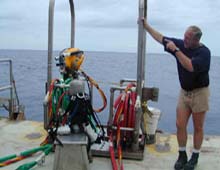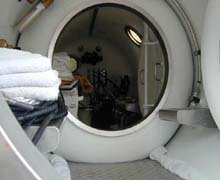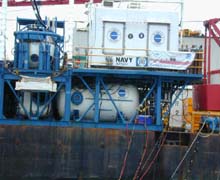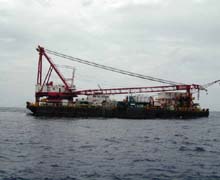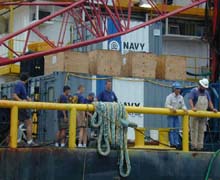
Members of the Wotan crew greet us as we near the barge. Have they spied the numerous bags of charcoal on our ship? Click image for larger view and detailed explanation.
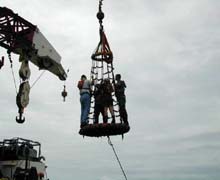
A seemingly flimsy but surprisingly sturdy platform lifts us off the Emmanuel and onto the Wotan. Click image for larger view and detailed explanation.
A Visit to the Wotan
July 24, 2002
Colleen Labbe
NOAA Ocean Service
Even the most experienced seafarer would have been nauseated by the tumbles of the little ship on rolling waves. Or so I told myself as I fought the sickness while a passenger on the little passenger ship Emmanuel. The seas were choppy, the clouds thick and dark, and the 90 minutes it took to reach the Wotan barge, about 20 miles off the coast of Cape Hatteras, NC, seemed like an eternity. Eventually, I could see the barge in the distance—a tiny speck on the endless Atlantic horizon. Even as we pulled up to the side of the Wotan, it seemed smaller than I expected. Though at least the size of a football field, it looked tiny in the middle of the ocean.
The men and women watching our approach from the Wotan looked happy to see us. I wondered if it was because they liked meeting the daily group of visitors, who would bring them news from the mainland, or if they simply eyed the soda, beer, charcoal and other sundries we carried to them. I pondered this for only a few minutes until I was hurried into a lifejacket. In groups of three or four, we were herded onto a smallish triangular platform, attached to a giant crane on the Wotan. The crane operator, once we’d secured ourselves onto the platform by grasping the ropes tightly, lifted us quickly over the watery gap between the Emmanuel and the Wotan, and gently set us onto the barge itself. For the 10 seconds while I hung there suspended, I forgot about my seasickness and smiled with a mixture of delight and alarm.
Once our group were all safely on the barge, we joined Captain Murray for an “official” tour. The captain described the layout of the barge and its operations. We stopped at the platform where the surface-supplied divers were dispatched. Here, he demonstrated the operations with flair. No diving today though, as the current was too strong—an unacceptable hazard to the divers. Navy seamen and women milled about, taking care of topside business, as they waited for the go-ahead to dive.None would come that day, at least while our tour group was there.At one point, I became engrossed in the video that the remotely operated vehicle was sending back. I quizzed the attending seaman about the status of the spider, which I could see on the video was clasped around the turret. The platform, he said, still lay beside the turret. Conditions had not allowed them to move it into position yet. Everything looked deceptively small on the video screen and I stared at it for a few minutes longer, fully aware that today I was part of history.
When I finally turned away from the video, I had lost my
group. I asked a few seamen if they had seen where everyone went. They all told me a different direction, so I decided to wander a bit. I walked around the barge, trying not to appear so conspicuous despite the clunky backpack I was wearing, full of camera equipment. I got some stares, though none of them unfriendly. I asked a few seamen if they had seen my group. None of them had, but a few were happy to show me around. One showed me to the “chow” room. Another showed me the small recompression chamber where the surface-supplied divers spent an hour or two after they emerged from the deep. In the tiny cylindrical-shaped room, the diver pointed to the oxygen masks, the blankets on which the divers lay, and the steel benches on which they sit. A claustrophobic’s worst nightmare, I thought.
I found my group again just as the skies broke and we braced for a downpour. Standing under a tarp, seamen who were obviously used to this worked to keep the heavy rain from collapsing the tarp. Tarp or no tarp, we were all soaked when the 10-minute shower ended.
Later, when Monitor historian Jeff Johnston showed me the saturation (sat) dive bell, I felt claustrophobic again just by looking at it. Eight divers lived for a week at a time in two tiny cylindrical-shaped chambers. Sometimes, Jeff said, because the divers lived in a constantly wet environment, their skin would be rubbed raw by their wetsuits and they would emerge from their sat diving stint with sores all over their bodies. I cringed, both fascinated and horrified by the work of the sat diver, and definitely more respectful.
Jeff also showed me the divers’ most indispensable tool used thus far—the hydroblaster. A slender, deceptively fragile-looking contraption, the blaster has cut through a huge amount of coal and other debris to help free the turret for excavation. Jeff and others predicted the turret would be raised within 10 days. However, another member of the expedition noted that it has been 10 days for about 10 days. The unpredictable and sometimes severe weather would likely determine the big day.
Soon, I could see the Emmanuel, which had been anchored not far from the barge, coming towards us. It was time to return. We boarded the rocking ship the same way we left it, via the swinging platform. I sat down on the floor of the ship, hoping to keep the seasickness at bay, and watched the Wotan get smaller and smaller until it disappeared completely. I closed my eyes to feel the rocking of the Emmanuel beneath me.
Sign up for the Ocean Explorer E-mail Update List.


































